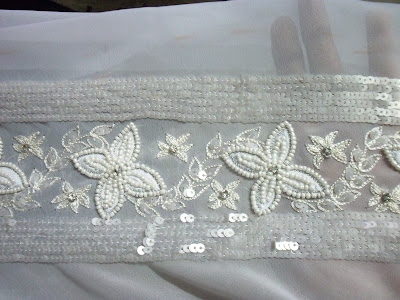Today i would like to write about smocking techniques. Smocking is an ornamental stitching where the fabric is gathered so that garment can be made without fastening as the smocked area can be stretched. It is suitable for yoke, bodice and cuffs. The technique has been known atleast since early medieval times but became especially popular in 17th and 28th century. It was traditionally used for farm quarkers smocks. They were loose outer garments worn to protect their clothes hence its name.
Today smocking is used primarily for babies and children's clothes and lingerie but it can be used for items purely for its decorative purpose.
Materials used for smocking techniques
Light weight cotton fabrics are most often chosen for smocking as the fabric must gather easily. Lacons and voiles are generally used. The fabric must be stable so that the design is not distorted. Knit fabrics are therefore not suitable. Smocking can be worked on fabrics with small regular patterns but it will not look good on fabric with larger or bold patterns.
Mostly cotton and silk threads can be used. Only one or two strands are used for fine fabrics though three or more may be used on heavier ones.
Smocking is worked with a crewel needle.
How to do smocking?
Gathering
Before beginning the embroidery the fabric must be gathered. This will reduce the width of the fabric, so begin with a piece three times as wide as how much ever will be required for the item. Always first ensure it will not shrink. Work a test piece so that you will know how it will look. Leave atleast 2.5 cms(1") all around the smocked area and oversew or bind the edges to prevent fraying.
Traditional Method of Gathering
On the wrong side of the fabric mark a grid of dots, aligning them on the straight grain. To do this place dress markers carbon paper on the fabric and a sheet of graph paper over it. Press a ball point pen against the intersections. Dots are usually 3 to 6 mm(1/8" to 1/4") apart and just be careful so that they do not smudge.
Flatten out the fabric. Using sewing thread in a color that contrast with the fabric, thread a needle; knot the end of the thread and make running stitches across each row of dots on the fabric. Leave a tail of thread at the end of each row. After finishing the running stitches, pull the tail of thread which you left at the ends of each row to make the gathers. Gathered threads are removed once the smocking is completed.
Image of backside of the fabric after gathering it
Alternative Method
Smocking can also be worked on fabrics with small regular patterns such as checks, dots of tiny flowers without the need for making dots. The pattern is used as guide for the gathering.
Mock smocking in which the dots are marked on the right side of the fabric and the smocking is worked out without prior gathering is also becoming more common.
General Methods For Smocking
Now the gathered fabric is ready for the decorative embroidery stitches to be done on the fabric.
1) Mark the center of the gathered area at the top and the bottom as a guide for later positioning of the garment pattern.
2) Work on the right side of the fabric along the row of gathered stitches from left to right.
3) Always anchor the thread firmly at the beginning of the row, using a double back stitch or a smocker knot.
4) At each stitch pick only the top thread of the pleat and always keep the needle horizontal and always pick up one pleat at a time.
5) Make each stitch either above the gathering thread or below it. Never make a stitch across it or the embroidery will be distorted or damaged when you remove the gathering threads.
Smocking Stitches
Applications of Smocking
Smocking technique has its wide application in children's clothing. Other products include prom dresses, pillow covers etc.















































